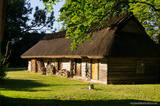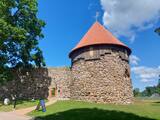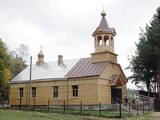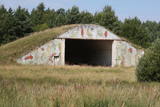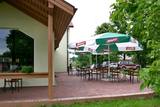| Nr | Name | Beschreibung |
|---|---|---|
|
Eine alte Ortschaft. In den 30er Jahren des 20. Jh. gab es hier 50 Bauernhöfe, aber im Jahr 1990 nur noch zehn. In Oviši ist der Wissenschaftler livischer Herkunft; der Entomologe Kārlis Princis (1893–1978) geboren, der 1944 nach Schweden ausreiste. Oviši Leuchtturm (1814) ist der älteste immer noch funktionierende Leuchtturm in Lettland mit einer Höhe von 38 m. Von hier oben bietet sich eine herrliche Aussicht. Das Personalgebäude des Leuchtturms wurde 1905 erbaut und war einst der Bahnhof der Schmalspurbahn. Im Nebengebäude wurde das Museum des Oviši Leuchtturms eingerichtet. In der Nähe des Leuchtturms befindet sich das Kunstobjekt Austra-Baum aus Metall. Dem Kap Oviši gegnüber ist ein guter Ort zurVogelbeobachtung. |
||
|
The ruins of the Rauna castle (which was built in 1262 and was a main residence of the Livonian archbishop) have a modern viewing tower which offers a view of the impressive castle walls, the place where the former Medieval city was located, and the centre of Rauna. The local government office has the keys to the tower.
|
||
|
Die drittgrößte Insel Estlands. Ist mit schönem Wachholderhain, kleinen Dolomitaufschlüssen und den Fischerdörfern an der Küste bedeckt. |
||
|
Die jahrhunderte alte Poststrasse führt zu Varbuse, wo sich die einzig intakten Poststation (1863) in Estland befindet. Früher gab es hier einen Pferdepoststation, heute ist hier das Estnische Strassenmuseum. Wenn Sie in den einzigartigen Expositsionsraum eintreten, können Sie die Verkehrsschilder sehen, die man auf den heutigen Straßen nicht mehr findet. Die Querschnitte der Straßenbeläge ermöglichen einen Blick in die Geheimnisse des Straßenbaus. Im historischen Straßenraum sind Strassenabschnitte dargestellt, so dass man den Hauch unterschiedlicher Zeitalter erleben kan. |
||
|
Eine der ältesten Ortschaften Litauens. Schon im 14. Jh befand sich hier eine Holzburg. Der 20 m hohe Merķine-Burgberg an der Mündung der Flüsse Merkys und Nemunas. |
||
|
The wetland meadows that are around the Pededze River are the site of this 200 ha farm with some 350 red deer, other deer and wild boar. There are towers from which you can watch the graceful animals, and there are ponds for commercial fishing. Please contact the owner well in advance for a tour. |
||
|
Das Gartenbauinstitut ist das führende Forschungszentrum für Obstbau und Gemüsebau in Lettland. Es befasst sich nicht nur mit der Auswahl und Einführung von Pflanzenarten, die für die landwirtschaftlich-klimatischen Bedingungen der baltischen Staaten geeignet sind, sondern stellt auch nahrhafte, ballaststoffreiche Lebensmittel aus den Gärten des Instituts her. Während der Frühlingsblüte haben die Gäste von Dobele die Möglichkeit, durch einen der größten Fliedergärten Europas zu spazieren, wo 240 verschiedene Fliederarten blühen. Im Mai/Juni können die Gartengäste des Gartenbauinstituts die Aprikosenbaum-, Kirschbaum-, Pflaumenbaum-, Apfelbaum-, Birnbaum- und Quittenbaumblumen genießen. |
||
|
In diesem Park kann man die von dem Besitzer gefertigten Einbäume, das Modell des Schlosses von Nurmiža und andere Gebäudemodelle, sowie ein Haus aus Sand besichtigen. Hier kann man an verschiedenen thematischen Veranstaltungen teilnehmen. Männer können hier Rinnen für die Gewinnung von Birkensäften fertigen, aber Frauen – Schmuckstücke aus Naturmaterialien basteln. Einbaum-Erzeugnisse wurden von den Menschen schon im Mesolithikum hergestellt, aber Einbäume (im Park sind mehrere davon) wurden mehr ab dem 9. Jh. benutzt. |
||
|
Der schönste Platz des Amata-Urstromtals mit Blick auf den Felsen, sowie auch vom Felsenabschuß (200 m lang und bis zu 44 m hoch). Am gegenüberliegenden Ufer befindet sich das Besucherzentrum. |
||
|
Nurka Farm is located in Luitemaa Nature Protection Area in Pärnu County. The farm complex that is over 100 years old has been renovated into a contemporary holiday farm with all modern conveniences. |
||
|
Der Livonische Orden hat 1342 auf der größten Insel des Alūksnes-Sees – Marijas bzw. Pilssala Insel eine befestigte Burg gebaut, die mit dem Seeufer eine 120 m lange Hebebrücke aus Holz vereinigte. Die Ordensburg hatte viele Vorburgen und wurde ständig bis zum Ende des 17. Jahrhunderts modernisiert und vergrößert. Diese Burg war eine der größten Burgen im Ostteil des Gebietes, das unter der Herrschaft des Livonischen Ordens stand. Ähnliche Burgen befanden sich in Vastseliina und Isborsk. In dieser Zeit wurden um die Burg herum die Schutzwallen errichtet. Die Ordensburg bestand bis zum Großen Nordischen Krieg, als 1702 die schwedischen geschlagenen Truppen einen Zentralteil der Burg in die Luft sprengten und ergaben sich, aber die russischen Truppen vollständig vernichteten. Heutzutage zeugen von den Ereignissen der damaligen Zeit die Burgruinen auf der Seeinsel, die mit dem Seeufer – dem Zentrum von Alūksne und dem Tempelberg – zwei Holzbrücken verbinden. In einem Konzertpavillon neben der Burgruinen finden verschiedene öffentliche Veranstaltungen statt. |
||
|
Viļāni Old-Believers Prayer House. The architect P.Pavlovs built Old-Believers Prayer House in 1930s.
The congregation was established very recently. Nevertheless the 14 meters high tower was constructed in
2004. The Prayer House is a very simple building but you will be pleased to see the magnificent icons. The
Prayer House has been renovated completely.
|
||
|
The craftspeople offer tours during which you can watch them at work. You can also produce your own souvenirs with various techniques, including the potter’s wheel and the engraving technique, making use of pre-prepared moulds. You can also commission and purchase ceramics products. This location is popular among children and wedding parties. |
||
|
Tūrisma gide Ineta Jansone piedāvā ekskursijas grupām uz Melnalkšņu dumbrāja laipu. Melnalkšņu dumbrāja laipa ir viena no īsākajām un interesantākajām takām Ķemeru nacionālajā parkā (600 m). Melnalkšņu dumbrājā Vēršupītes krastos novērojami dabiskam mežam raksturīgi elementi – jauni, kā arī veci un dobumaini koki, kritalas, sausoņi, ciņi. Daudzveidīga ir meža putnu fauna. Jebkurā gadalaikā melnalkšņu dumbrājs ir īpašs. Taču visā krāšņumā dumbrājs atklājas tieši pavasarī. Vēršupītes pālu laikā ūdeņi pārklāj lielāko dumbrāja daļu, bet visapkārt zied zeltainās purenes, gaiss vibrē no putnu dziesmām un dzeņu bungošanas. |
||
|
Divstāvīgs skatu tornis pie Laikjula (Laiküla) – Hāpsalu ceļa, no kuras paveras plaša ainava uz Matsalu līcī ietekošo upīšu palieņu pļavām. Te var vērot migrējošās dzērves un zosis, bet pavasaros varbūt laimēsies redzēt vai dzirdēt ķikutu Gallinago media. Viens no retajiem torņiem, kas ir pielāgots cilvēkiem ar īpašām vajadzībām. |
||
|
In der Station der Zenitraketen Ziemupe 158 sind manche Gebäude, Raketenplätze und ein Wohnhaus erhalten geblieben. Das Objekt wird nicht genutzt. Das Territorium ist verlassen und degradiert.
|
||
|
Das Café befindet sich im Zentrum von Dundaga, im Gästehaus Krūziņi. Lettische Küche: Sauerkrautsuppe, graue Erbsen mit Sauermilch, gebratene Flunder oder gebratener Kabeljau, Sauersuppe mit Kartoffeln. Das besondere Gericht : Turm aus Quark oder eine Creme aus den Produkten der Molkerei von Dundaga. |
||
|
This is the thickest common juniper (Juniperus communis) in Latvia and the Baltic States. It stands in the middle of a field and looks wonderful. The tree is sometimes known as the Rieteklis juniper, because the Latvian poet Rieteklis (Jūlijs Eduars Balodis, 1856-1940) like to sit under it.
|
||
|
Die Brotküche befindet sich im Dorf Obinitsa, im Sommer ist sie jeden Tag und im Winter auf Anfrage geöffnet. Workshops zum Backen von Weiß- und Roggenbrot mit Sauerteig. In Café werden Steinofenbrot ohne Form, Brot mit Samen, verschiedene Weißbrote gebacken. |
||


